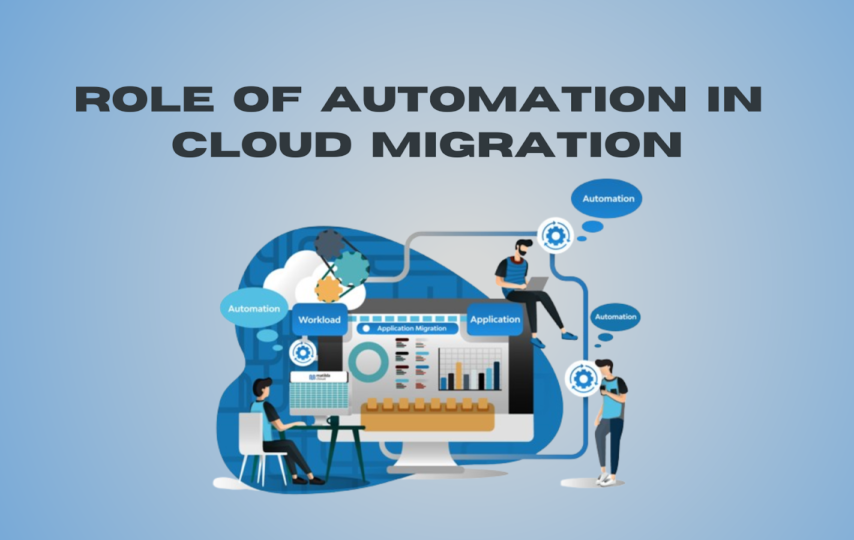The migration process to the cloud is now critical for enterprises seeking to update the IT management approach and grow productivity. However, that process cannot be undertaken easily and requires overcoming several factors, such as data security concerns, risks of downtimes, and human errors.
Automation in cloud migration has raised a new wave since traditional approaches to migrating applications and data have incorporated automation, where most tasks are automated and efficient. It makes cloud migrations far more effective, with less risk for mistakes and more security, consequently cutting costs.
This blog post will focus on understanding the role of automation in cloud migration, the approaches that automate the process, and overcoming give-and-take, the latest tools that shape cloud migrations.
How Automation Simplifies Cloud Migration Challenges
Automation helps solve many challenges that come with cloud migration. Here’s how:
- Big Data Management: Transferring mass data is not particularly easy. Automation techniques help generate data quickly and with fewer errors.
- Minimizing Downtime: Manual migration can lead to downtime. Automation ensures the process moves faster and without significant interruptions.
- Reducing Human Errors: As will be noted during manual migration, human errors can easily cause data corruption or loss. These risks are avoided in automation since most tasks are performed with minimal human interface.
- Standardized Configurations: Many cloud migration issues arise from overlooked settings, leading to security problems. Automation minimizes such risks because configurations are always standardized.
- Continuous Monitoring and Rollback: Real time tracking of the migration process is possible by using automated tools. If there is a problem, they can restore settings to a prior working state to avoid significant service loss.
- Handling Complex IT Infrastructures: As the complexity of the infrastructure increases, organizations find it easier to scale up or perform multiple migration tasks simultaneously.
- Improved Workflow Automation: Automation also rationalizes business process management (BPM) and decreases the dependence on managers’ interventions to resolve specific problems, delivering more valuable work to the IT teams.
Next-Gen Automation: What’s New in Cloud Migration Technologies?
Automation in cloud migration is evolving rapidly. Next-gen tools are more advanced and help streamline the process in several ways:
- AI and Machine Learning Integration: The new automation tools include an AI and ML capability that allows them to identify issues that may be encountered during the migration process and provides timely recommendations on how to avoid failure.
- Predictive Analytics: This makes it easy to determine when to transition workloads from manual to automated systems for minimal resource hitches.
- Automation in Leading Cloud Platforms: AWS, Microsoft Azure, and Google Cloud providers have recently become more streamlined in creating automation programs. These are examples of infrastructure, such as code and real-time monitoring, instead of using templates to manage the resources.
- Real-Time Monitoring and Decision-Making: Software tools for migration monitoring assist companies in monitoring migration progress in real-time and making decisions at any stage of the cloud migration strategy.
- Efficiency and Risk Reduction: As automation becomes more intelligent, it must increase efficiency and eliminate hindrances that might slow down a process, helping organizations attain their migration goals in the shortest time possible and with minimal risks.
In the next-generation automation across the cloud migration process, there is more than the value for efficiency. There is another value in applying the most current and high-quality decision-making tools that will make or break the cloud migration strategy.
Balancing Automation and Human Expertise in Cloud Migration
Automation in cloud migration is incredibly valuable, but human expertise is still crucial. Here’s how both work together:
- Automation Enhances Human Work: Automation helps by taking over repetitive tasks like workload transfers and reconfigurations, allowing IT professionals to focus on more complex issues.
- Customization Needs Human Input: While automation tools handle many tasks, the overall migration strategy still requires human intervention. Specialists customize tools based on the company’s specific needs and handle unexpected issues during migration.
- Monitoring and Troubleshooting: Certain functions, like diagnosing problems and guaranteeing stable cross-platform transitions, should be conducted only by humans. As seen above, automation in cloud migration can be helpful; however, it cannot completely solve the problem and allows top talent experts to come in whenever needed.
- Automation Supports, Not Replaces: The practice of cloud migration is facilitated through the automation of processes, which minimizes mistakes and increases the rate of work done. However, it cannot eliminate the need for people to plan, strategize, and execute.
In other words, technology-based automation of the migration process is productive because it leverages human capacity to work more efficiently. Still, migration line management is always in the hands of IT specialists.
Scaling Your Cloud Migration Efforts with Automation: A Roadmap for Success
Many organizations look forward to achieving big goals with automation in cloud migration for significant growth, but it should be systematic. Here’s a roadmap to help businesses harness the full potential of automation:
- Planning: First, it is followed by an evaluation of the current state of your IT processes to determine which activities can be effectively outsourced to automation. The automation tools should be selected depending on the type of workload, the data being transported to the cloud, and the organization’s overall long-term cloud strategy.
- Automation Integration: Another best practice is to begin automation at the data migration phase. The capturing of time-consuming processes such as infrastructure setup and deployment, data transfer and application re-hosting, and rebalancing have been automated to reduce possible human errors.
- Monitoring and Testing: Automated monitoring tools allow you to know about potential problems as soon as they occur. Set up automated testing systems that will continuously validate the health of your workloads and ensure that they function correctly after migration.
- Optimization: Post-migration automation can continuously optimize cloud resources. This includes automating scaling and capacity adjustments based on workload requirements, ensuring efficient cloud utilization.
- Security Automation: Incorporate automated security measures during and after migration. Security tools that can enforce security policies, conduct some scans, and detect some threats when migrating to the cloud can help minimize many risks.
According to this roadmap, organizations are assured that they are setting up the automation process to accommodate future growth and more demanding needs.
The Future of Automation in Cloud Migration
It is significant to observe that the importance of cloud migration is increasing in parallel with the significance of automation in cloud migration. With automation, the overhauled transition is simplified and made less dangerous, and at the same time, the speed and pace of the whole process are much better. In the future, AI, machine learning, and other automation tools will make the cloud migration process in businesses more intelligent, faster, and safer.
Given the increasing rate of change in this field, automation cannot be an option for businesses that aim to maintain high levels of competitiveness. Moreover, cloud migration services provide the necessary tips and support for business organizations to get the proper benefits of automation in migration, which has been a significant challenge all these days.
Happy Clouding!!







